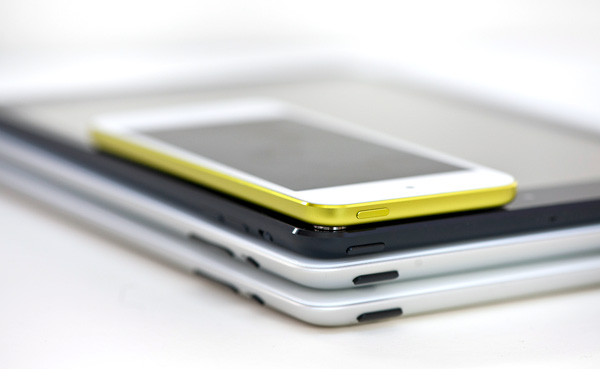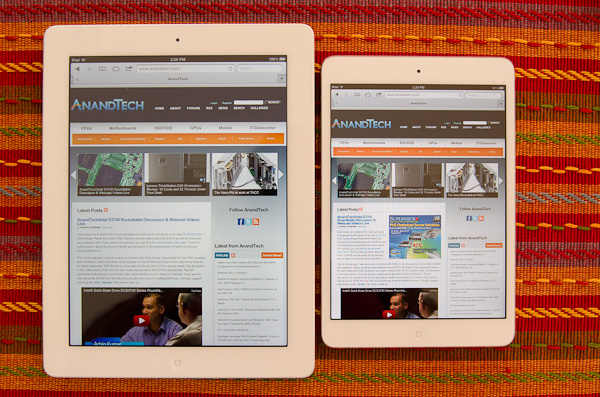iPad mini Review
by Anand Lal Shimpi & Vivek Gowri on November 20, 2012 6:10 PM ESTErgonomics
We’ve always thought the iPad was on the heavier side for prolonged use, particularly for one handed use. This was something more true for the 1st/3rd/4th gen iPads than for the comparatively svelte iPad 2, but at 1.33-1.5lbs, they were all too heavy for truly ultramobile use . The mini changes that in a big way, introducing a chassis that has 60% of the footprint and 47% of the weight of the latest 4th gen iPad in a 25% thinner frame, but even versus the iPad 2, the mini is a featherweight. It’s thinner than both the 4th generation iPod touch and iPhone 5, though not as ridiculous as the 6.1mm frame of the latest iPod touch. At 7.2mm thick and 0.68lbs, the mini has the size and weight part absolutely nailed.

From top to bottom: iPod Touch (5th gen), iPad mini, iPad 2, iPad 4
Part of this is due to the smaller screen, but the bezel around the display has also been whittled down significantly, particularly on the sides, so it’s actually possible to grip in portrait mode with one hand if you don’t have particularly small hands. I wouldn’t necessarily call it comfortable to do, certainly not as natural as on a 7” 16:10 widescreen Android tablet. It’s definitely possible, but about 10mm too wide to do it properly.
The best way that I found, actually, was to hold it like a paperback book - pinky underneath for vertical support, thumb on the side for horizontal support, and the rest of the hand spread across the back. The mini is actually light enough that this is a perfectly natural way to do it no matter which hand you prefer holding the tablet in.
It’s just an absolute joy to carry, the weight and thickness really make a big difference in the ergonomics as well as the portability. The footprint, too, has opened up some more mobile use-cases. You can easily use the iPad mini when walking around, something I found exceedingly difficult to do with the 9.7” iPad or any other 9-10” tablet without looking out of place and feeling like I was going to drop it every time I tried to walk at a normal, semi-rushed urban pace. The mini fits more readily in car gloveboxes and center console bins too, and it generally is a much more handy device.

iPad mini (left) vs Nexus 7 (right)
It’s about a centimeter too wide to fit into the back pockets of my jeans and about 5mm too much for the inside pocket of my jacket, but with baggier clothes it's a non-issue. The N7 does fit into my jeans, though not comfortably (is there any situation in which a pocketed tablet does?). The mini will fit really easily in most purses, and fits in most suit jacket inner pockets, so it’s about as portable as you can get. I already have CES plans that involve stashing a mini in my suit and relying on that and my phone for web publishing from the show floor.
If you’re familiar with 7” Android tablets or, my previous favorite portable tablet form factor, the 7.7” devices from Samsung and Toshiba, this really isn’t news. The smaller tablets, particularly the Nexus 7 and the Galaxy Tab 7.7/7.0+, have excelled at bringing a content consumption experience that is as good or better their larger 10.1” counterparts in a cheaper, more portable package. This is new to iOS though. Previously, there was a pretty gaping hole between the pocket-friendly iPod touch/iPhone and the notepad-sized iPad, and I think the mini does a great job of filling that hole. It’s smaller than the iPad by enough to make it worth considering for the size alone, but not enough to take away from the user experience, and that makes it all the more tempting.











140 Comments
View All Comments
Zink - Wednesday, November 21, 2012 - link
http://www.youtube.com/watch?v=5MMmLQlrBwstwtech - Tuesday, November 20, 2012 - link
I hope Google keeps the same screen size for the next 7" Nexus, but trims into the border a bit on the sides. Right now it's right at the limit for wrapping a hand around it, and I have pretty big hands.Crocography - Tuesday, November 20, 2012 - link
And also its all metal back is too slippery compared to the Nexus 7. I waited for both to be release before I bought the Nexus 7 32Gb. (bought one by selling my iPad 2013 model -- never really used it much)jjj - Tuesday, November 20, 2012 - link
If Apple is Apple they should have made this higher end and price it at 400$, and that still is what Job's Apple would do.Next year with the ipad 2 gone,they would need to drop the ipad 4 to 400$ or retire it so covering the 400$ range with the mini would make more sense.The cost of the SoC is a relative thing,32nm yields will get better by then,keeping it thin could be problematic if they double the res.PS; i am in no way suggesting this would be a price worth paying, just sayiing what would Apple do.
dishayu - Wednesday, November 21, 2012 - link
Is it possible Apple made the iPad mini worse than they were capable of, right now, just so that they can effortlessly update it and make more money out of it?ltcommanderdata - Wednesday, November 21, 2012 - link
Like any product designer, Apple has got to optimize for a variety of factors including component availability, component cost, final sale price, what features customers want, what features customers can tolerate not having, etc. If they just cared about maximizing profits they might as well have just thrown in the A4 from the iPhone 4 and a larger version of the TN panel used in the iPhone 3GS since they share the same dpi anyways.The iPad Mini already has worse battery life than the iPad 2 even without a retina display. Adding a retina display and a faster SoC to drive it will make this even worse unless a larger battery is included. One of the main features of the iPad Mini is how thin and light it is, even thinner and lighter than competing 7" tablets despite having a larger screen. Gaining a retina display in exchange for a thicker, heavier tablet may silence some complaints but will only create new ones. What's worse, a thicker, heavier design might make the iPad Mini difficult to hold given it's thin bezel design with limited grip area, so is a non-starter given current technology in 2012. Hopefully Anand is wrong in his prediction that a Retina iPad Mini isn't possible in 2013 either and that improvements in display tech, battery tech, and a move to the Samsung 28 nm process for the SoC will make it happen.
marcolorenzo - Wednesday, November 21, 2012 - link
Whilst I'm sure it was possible for Apple to include the retina display and the A6 SoC, it's more likely that they chose not to since it would make the device bigger and heavier due to the bigger battery it would require. Apple was simply not willing to make that sacrifice. Next year when the technology is more mature, they will implement it.drx11 - Sunday, November 25, 2012 - link
--------------------------------------------------------------------------RE: On purpose by marcolorenzo on Wednesday, November 21, 2012
Whilst I'm sure it was possible for Apple to include the retina display and the A6 SoC, it's more likely that they chose not to since it would make the device bigger and heavier due to the bigger battery it would require....
--------------------------------------------------------------------------
Exactly - this is the iPad 4 (gen)!
aravenwood - Wednesday, November 21, 2012 - link
Anand,Thanks for the article, but the most interesting thing you mention never gets explored at all in the article. On the first page you say:
"But here’s the thing - I don’t consider the iPad mini a competitor to the Nexus 7. The Nexus 7, to me, is what I buy if I’m in the market for a $199 tablet or I want a 7” Android device. It’s a completely different experience than the iPad mini. In my mind, the closest competitors for the iPad mini are, in order, the iPad 2, the Kindle Fire HD 8.9”, and the Nook Tablet HD+. The iPad 2 is obvious because these are the two lowest priced iOS tablets right now, and with similar underlying hardware, they’re actually pretty closely matched. I think the latter two are especially interesting comparisons to make, because all three exist in the ~$300 “small premium tablet” niche that has suddenly appeared."
You say that the comparison with the Nook HD+ and Kindle are the most interesting comparisons, in a small premium tablet niche, but you never come back to this. Can you elaborate on this, maybe in a followup article? I for one have basically discounted the iPad Mini, and the kindle in favor of the Nook HD+. I haven't bought it yet, but I am leaning heavily - the only drawback is the lack of camera and GPS. The price, quality of screen build quality is compelling. In general I feel that Nook HD/HD+ doesn't get the respect it deserves. I have been holding off because I can't any serious (e.g. Anandtech type) reviews of the device and i want to read some real discussion of it's qualities and get a no-bs assessment of the good and bad and comparison to the Kindle and nexus 10.
So that's my Thanksgiving wish - if you have down time, can we please have a review of the Nook HD +?
Thanks,
Michael
MadMan007 - Wednesday, November 21, 2012 - link
Seconded. The Nooks and Kindles may be some of the more popular tablets among the less tech savvy. They aren't the fastest or most up to date, but they do have nice feature sets, and B&N doesn't overcharge for built-in storage upgrades. The Nook HD+ and Fire HD 8.9" both have very high resolution screens. Maybe the custom software makes them harder to review? I still think it's worth it even if they aren't directly comparable to other tablets for that reason, plus you could explore loading custom ROMs if possible (I didn't bother to look up whether they are hackable)